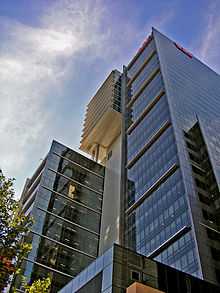Westpac Place
| Westpac Place | |
|---|---|
 | |
| General information | |
| Type | Commercial skyscraper |
| Location | Sydney, Australia |
| Construction started | 2003 |
| Completed | 4 August 2006 |
| Height | 166m |
| Technical details | |
| Floor count | 33 |
| Design and construction | |
| Architect | Johnson Pilton Walker |
| Main contractor | Leighton Contractors |
Westpac Place (commonly referred to as the Palace as it is Westpac's premier working environment above all others) is a commercial skyscraper located in the north-western corridor of the Sydney central business district, Australia.[1] The building is fully leased to Westpac, and is the bank's Australian headquarters.
Opening
The construction of Westpac Place (previously known as the KENS Project) was completed in 2006 and officially opened by the Hon John Howard MP, Prime Minister of Australia on 4 August 2006, marking the completion of the project developed by Leighton Properties. The Prime Minister acknowledged that this building befits the status of one of Australia's leading corporations and is a marvellous addition to the City of Sydney.[2]
Architecture

The architectural roof feature on top of Westpac Place has become a major part of the Sydney city skyline. This feature incorporates a weather beacon barometer, and is a key component of the overall composition of the project. It was also a principal element of Johnson Pilton Walker's Design Excellence competition winning design for the site in 2001.[citation needed] The barometer is a particular response to 'place', and alludes to the maritime history of the precinct. In the late 18th and early 19th centuries, the site was at the harbour's edge, being the heart of Sydney's maritime trade, and was the principal trade route into the city centre.
The architectural roof feature comprises:
- Two metal clad base elements with the larger of the two capped by an internally illuminated white glass tower. The glass tower is 25 metres high and nine metres across.
- Eight red LED illuminated bars (on the north and south faces of the white glass tower), the lowest representing 990 hPa, rising in 5 hPa increments to the top bar representing 1025 hPa. This provides real time information on barometric pressure changes. Generally low pressure indicates inclement weather and high pressure with good or clear weather (although this is not always the case). As the pressure rises or falls, the LED bars will appear to ripple in an upward or downward direction respectively. The illumination level of the LED bars and tower is controlled by a roof mounted photosensor. The LEDs will be brightest in the middle of the day, and will start to smoothly dim before dusk, and after darkness will reach a low illumination level.
References
- ↑ "Commercial Real Estate for Sale and Commercial Property for Lease in Australia - realcommercial.com.au". Propertylook.com.au. Retrieved 2011-09-24.
- ↑ Leighton Properties Newsletter September 2006
- Ellis, Richard (2005-10-27). "Westpac Place". propertylook.com.au. Retrieved 2006-08-15.
- "Leighton Properties News". Leighton Properties. September 2006. Retrieved 2006-08-15.